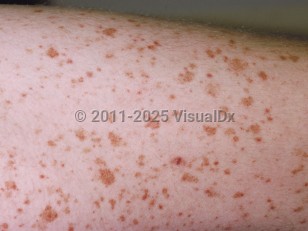Capillaritis in its most common form is typically asymptomatic, but in some types, it may be pruritic, mildly painful, or may burn. It is usually chronic with intermittent exacerbations and remissions. There is no geographic or hereditary predilection. Atypical presentations of capillaritis not consistent with the following classification should raise the suspicion of some other underlying condition.
The well-described PPDs are:
Classic forms
- Schamberg disease – the most common manifestation of PPD; affects middle-aged to older men
- Purpura annularis telangiectodes (Majocchi disease) – uncommon; affects adolescents to young adults; most common in females
- Eczematid-like purpura of Doucas and Kapetanakis – a more inflammatory and less common subtype of Schamberg disease
- Pigmented purpuric lichenoid dermatosis of Gougerot and Blum – rare; most common in middle-aged men
- Lichen aureus – most common in young men
- Linear pigmented purpura – uncommon; most commonly affects children and adolescents
- Granulomatous pigmented purpura – very rare; most common in middle-aged to older adults and Asian individuals
- Golfer's vasculitis (exercise-induced vasculitis; hiker's rash) – relatively common but underrecognized. Lower leg PPD associated with prolonged walking or hiking in hot and humid conditions. Seen mostly in people aged 50 years and older. It typically spares the compression band area of socks and resolves over a few days without treatment.



 Patient Information for
Patient Information for 
